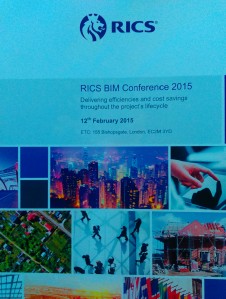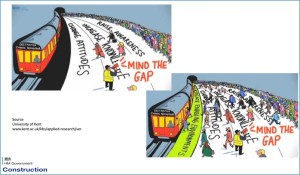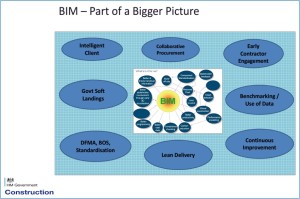 We need BIM (Building Information Modelling/Management), don’t we?
We need BIM (Building Information Modelling/Management), don’t we?
Certainly from the attendance at the annual RICS BIM Conference, held on 12th February 2015, you would appreciate the significance of BIM and so be left in little doubt that we do indeed need BIM. This was the fourth RICS BIM conference and having participated in the previous events, it is evident the BIM journey has well and truly begun for many people in the industry. This term “BIM Journey” was used constantly throughout the day and it’s one I want to focus on in this post.
Where have we come from on this journey? Where is it going? And what if you’re not on board; do you even need to be?
 Where have we come from? At the first conference, there was a lot of enthusiasm and interest into what BIM is all about; but as the keynote speaker indicated to me, it’s not until people start complaining about BIM that he would know people are starting to get the message about the challenges involved. David Philp advocated everyone should get on board the BIM Train before it left the station, the message being start now or you’ll get left behind! In 2013 and 2014 it was more of the same; lots of enthusiasm mixed with presentations from those that were gaining experience of BIM.
Where have we come from? At the first conference, there was a lot of enthusiasm and interest into what BIM is all about; but as the keynote speaker indicated to me, it’s not until people start complaining about BIM that he would know people are starting to get the message about the challenges involved. David Philp advocated everyone should get on board the BIM Train before it left the station, the message being start now or you’ll get left behind! In 2013 and 2014 it was more of the same; lots of enthusiasm mixed with presentations from those that were gaining experience of BIM.
For me in 2015, it was the excellent live demonstrations from Trevor Woods and Cathy Molloy that not only highlighted the practical challenges of using BIM, but also how far some people have progressed on their BIM journey.
So where is this BIM Journey going?
I was drafting this post whilst commuting into London and it made realise that the analogy of journey is really important. Would I prefer not to commute, to take this train journey? Probably, but it’s a necessary journey that I have to make as I’m required to be in the University to teach my students. In other words, it’s a journey that helps me fulfil my aims, which are my contractual obligations to my employer and, ultimately, to get paid! I do have other journey options, but the train is the most efficient option at the current time and will be until Scotty becomes a reality (one for you trekkies out there!) Moreover, I can use the commuting time to do other activities such as blog writing on my tablet.
So like my commute, BIM would appear to be a necessary journey; in which case you should ask yourself: where are you heading? How are you maximising the benefits of the journey?
To answer my first question, do we need BIM, you need to ask yourself what you are trying to achieve; what are your outcomes?
I would suggest that, if it isn’t already, BIM will  become an integral component of the project life cycle. As Terry Stocks described in his keynote, BIM is an important part in the bigger picture alongside improving client capability, developing collaborative procurement practices, getting early contractor engagement, soft landings, benchmarking etc.All of which contribute to delivering better outcomes for clients and the supply chain. Is this where you are heading?
become an integral component of the project life cycle. As Terry Stocks described in his keynote, BIM is an important part in the bigger picture alongside improving client capability, developing collaborative procurement practices, getting early contractor engagement, soft landings, benchmarking etc.All of which contribute to delivering better outcomes for clients and the supply chain. Is this where you are heading?
Whilst David Philp urged us to get on board the BIM train, I would also suggest that there is more than one train and it’s certainly not too late. But start your journey by being clear of your outcomes, and then look to get onboard your BIM journey as soon as possible.
Slides used with permission of Terry Stocks from his Keynote talk at 2015 RICS BIM Conference
